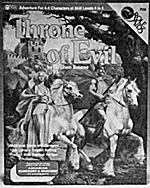
By Stephen Bourne
Mayfair Games, Inc.
PO Box 5987, Chicago, IL
60680
Released: January, 1985
Catalogue No.: 723
Price: $6.00
Complexity: Intermediate
Solitaire Suitability: Low
Throne of Evil is something of an oddity it's one of Mayfair's, RoleAids Dungeons & Dragons adventures, this time set in 12th-century England ... sort of
Throne of Evil comes as an 8 1/2" x 11" 32-page booklet. The cover art is by Rowena-a reprint of her 1978 cover from The Crimson Chalice. The cover art puts Throne of Evil head and shoulders over most game supplement covers; it even has some vague similarity to incidents in the adventure and, amazingly, is less oily in appearance than most of Ms. Morrill's work.
The adventure itself is a peculiar one. It's set, more or less, in the England of around 1140 A.D. Henry I has died; his daughter Matilda and her husband Geoffrey of Anjou vie with Henry's nephew Stephen of Blois for the crown of England. Historically, Stephen held the crown for about 20 years, and then Matilda and Geoffrey took it after his death. Geoffrey and Matilda were the parents of Henry II, who was the first of the Plantagenet kings, father of Richard the Lion- Hearted and John Lackland, and so forth.
For this adventure, author Stephen Bourne has added a new character: Mortimer, the March Lord, who is basically the power behind Stephen of Blois and the puppetmaster pulling Stephen's strings. (This March Lord seems to have been based loosely upon a real-life Mortimer:
Roger, the first Earl of March, who lived and died about two centuries atter the events in this adventure.)
The goal of the adventure is simple: the adventurers must be persuaded to aid Geoffrey and Matilda by kidnapping the March Lord for them. To do this, they must sneak into his fortress, grab him, and sneak him back out again. But the March Lord Wraithstone Castle is built atop some ancient Celtic caves, filled with magical weirdness and danger. And Mortimer and his castle followers aren't pushovers themselves. Getting into the castle becomes a war of attrition; capturing the March Lord and escaping will require all varieties of skills and magic.
In short, the adventure itself is challenging, reasonably well-presented, and interesting; additionally, it's a "story" adventure (one with a beginning, middle, and variety of ends, some interesting non-player characters (NPCs), and the possibility for future plot ripples) instead of a static "dungeon" adventure.
But, as I've mentioned, it is a strange scenario. It not for everyone. Why not? Well....
First, as I've mentioned, it's set in 12thcentury England. Not very many campaigns are set in 12th-century England. (You might find campaigns set a couple of generations later, when Richard the LionHearted, Robin Hood, and Ivanhoe are all running amok; but the author admits that Throne of Evil is set during one of the lesser- known Norman periods.) Evidently assuming that this will not be played as part of an ongoing campaign, the author has provided several characters for the players to use.
Second, even though it is set in historical England, there's an awful lot of magic and other D&D oddness around. The caverns under the castle are stocked from the Monster Manual. The gold reward to the player-characters is in generic D&D gold pieces, not in English coin, and is provided in an excessive amount for historical Britain. And the player-characters provided include only one human; the rest include one elf, two half-elves, and two dwarfs. I think an all- human cast would have been a bit more appropriate.
I have to conclude that this is only good as a one-shot setting. it can be a fun adventure, but lots of Gamemasters and players, including me, prefer ongoing characters in ongoing campaigns and won't have much use for it. The castle is a nice, reusable setting, but little else is very durable from this scenario.
Bourne has done some homework and put together an eccentric and suspenseful little adventure. But I can only recommend it if you already have a Norman-era campaign, or tend to play a lot of one-shots. One other option with a lot of conversion work you can use this with a timetravelling game, such as Pacesetter's Timemaster or a superhero game involving occasional time-travel.) I look forward to seeing more works from Stephen Bourne; even constrained by D&D norms, he has put together a personable adventure. I just hope to see less specialized material from him in the future.
More Reviews
-
Game Review: Time Master: Sea Dogs
Game Review: Bandit Gangs and Caravans
Game Review: Throne of Evil
Game Review: Convoy
Game Review: The Desert Environment
Game Review: Trouble for Havoc
Game Review: F-15 Strike Eagle (Computer Sim)
Game Review: Web and Starship
Game Review: Napoleon in Spain
Game Review: Struggle for the Throne (Star Trek)
Game Review: Forces of Fantasy
Game Review: Talisman
Game Review: Dragonriders of Pern
Game Review: King's Court
Game Review: The Soap Opera Game
Game Review: Judge Dredd
Back to Table of Contents -- Game News #4
To Game News List of Issues
To MagWeb Master Magazine List
© Copyright 2000 by Dana Lombardy.
This article appears in MagWeb (Magazine Web) on the Internet World Wide Web.
Other military history articles and gaming articles are available at http://www.magweb.com